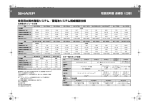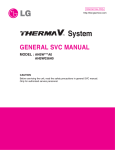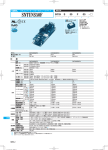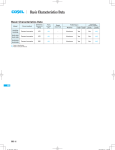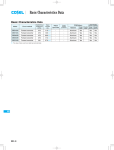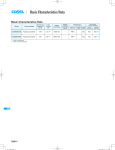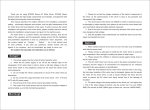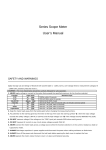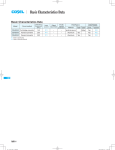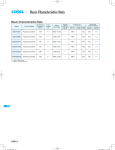Download Basic characteristics data • Instruction manual
Transcript
Basic Characteristics Data Basic Characteristics Data Model TUNS50F TUNS100F TUNS300F TUNS500F TUNS700F Circuit method Switching frequency [kHz] Active filter 80-600 Flyback converter 100-300 Active filter 80-600 Forward converter 300 Active filter 100 Half-bridge converter 400 Active filter 100 Half-bridge converter 400 Active filter 100 Half-bridge converter 400 *1 The value of input current is at ACIN 100V and rated load. *2 Refer to instruction manual. TUNS TUNS-12 Input current [A] *1 Inrush current protection circuit Material 0.67 Thermistor Aluminum 1.3 Thermistor 3.6 PCB/Pattern Single Double sided sided Series/Parallel operation availability Series operation Parallel operation Yes Yes *2 Aluminum Yes Yes *2 SCR Aluminum Yes Yes *2 6.0 SCR Aluminum Yes Yes *2 8.6 SCR Aluminum Yes Yes *2 AC-DC Power Supplies Power Module type Instruction Manual TUNS50F, TUNS100F TUNS300F, TUNS500F, TUNS700F 1 Pin Connection TUNS-14 1 Pin Connection TUNS-21 2 Connection for Standard Use TUNS-14 2 Connection for Standard Use TUNS-21 3 Wiring Input/Output Pin TUNS-15 3 Wiring Input/Output Pin TUNS-22 3.1 Wiring input pin TUNS-15 3.1 Wiring input pin TUNS-22 3.2 Wiring output pin TUNS-15 3.2 Wiring output pin TUNS-22 3.3 Wiring +BC/-BC pins TUNS-15 3.3 Wiring +BC/-BC pins TUNS-22 4 Function 4 Function TUNS-23 4.1 Input voltage range TUNS-16 4.1 Input voltage range TUNS-23 4.2 Overcurrent protection TUNS-16 4.2 Overcurrent protection TUNS-23 4.3 Overvoltage protection TUNS-16 4.3 Peak current protection TUNS-23 4.4 Thermal protection TUNS-16 4.4 Overvoltage protection TUNS-23 4.5 Remote sensing TUNS-16 4.5 Thermal protection TUNS-23 4.6 Adjustable voltage range TUNS-17 4.6 Remote ON/OFF TUNS-23 4.7 Withstanding Voltage/Isolation Voltage TUNS-17 4.7 Remote sensing TUNS-24 4.8 Adjustable voltage range TUNS-24 4.9 Inverter operation monitor (IOG) TUNS-25 4.10 Withstanding Voltage/Isolation Voltage TUNS-25 5 Series and Parallel Operation TUNS-17 5.1 Series operation TUNS-17 5.2 Parallel operation TUNS-17 6 Implementation-Mounting Method 7 TUNS-16 5 Series and Parallel Operation TUNS-25 5.1 Series operation TUNS-25 5.2 Parallel operation TUNS-25 5.3 N+1 redundant operation TUNS-26 6 Implementation-Mounting Method TUNS-26 TUNS-18 6.1 Mounting method TUNS-18 6.2 Stress to the pins TUNS-18 6.3 Cleaning TUNS-18 6.4 Soldering temperature TUNS-18 6.5 Derating TUNS-18 6.1 Mounting method TUNS-26 6.6 Heat sink (Optional parts) TUNS-19 6.2 Stress to the pins TUNS-26 6.3 Cleaning TUNS-26 6.4 Soldering temperature TUNS-26 6.5 Derating TUNS-26 Lifetime expectancy depends on TUNS-20 stress by temperature difference 7 Peak current 8 TUNS-27 Lifetime expectancy depends on TUNS-28 stress by temperature difference TUNS-13 TUNS AC-DC Power Supplies Power Module type 1 Pin Connection ¿TUNS50F TUNS50F, TUNS100F Instruction Manual 2 Connection for Standard Use ¡To use TUNS series, connection shown in Fig.2.1 and external components are required. 7-VOUT 6TRM 5+VOUT 1AC1 ¡This product uses conduction cooling method (e.g. heat radiation from the aluminum base plate to the attached heat sink). Reference: 6.5 ”Derating” 2AC2 3+BC 4-BC 2-FG Heatsink ¿TUNS100F +S TH1 F1 9-VOUT 1AC1 8-S 7TRM 6+S 2AC2 AC IN Noise filter FG FG +VOUT TUNS50F Co TUNS100F AC2 -VOUT AC1 C1 FG +BC Cbc + Load -BC -S + C2 CY 5+VOUT +S, -S : TUNS100F 3+BC 4-BC 4-FG Fig.2.1 Connection for standard use Fig.1.1 Pin connection (bottom view) Table 1.1 Pin connection and function TUNS No. Pin Function TUNS50F TUNS100F Connection AC1 1 1 AC input AC2 2 2 +BC +BC output 3 3 -BC -BC output 4 4 +VOUT +DC output 5 5 -VOUT -DC output 7 9 -S Remote sensing (-) 8 +S Remote sensing (+) 6 TRM Adjustment of output voltage 6 7 FG Mounting hole (FG) TUNS-14 Table 2.1 External components No. Symbol Components 1 F1 Input fuse 2 C1 Input Capacitor 3 Noise Filter 4 CY Y capacitor 5 TH1 Inrush current protection thermistor 6 Co Output capacitor 7 Cbc Smoothing Capacitor for boost voltage 8 C2 Capacitor for boost voltage 9 Heatsink Reference 3.1 “Wiring input pin (1)” 3.1 “Wiring input pin (2)” 3.1 “Wiring input pin (3)” 3.1 “Wiring input pin (4)” 3.2 “Wiring output pin (1)” 3.3 “Wiring +BC/-BC pins (1)” 3.3 “Wiring +BC/-BC pins (2)” 6.6 “Heat sink” AC-DC Power Supplies Power Module type 3 Wiring Input/Output Pin Instruction Manual TUNS50F, TUNS100F ¡The output voltage may become unstable at low temperature due to the ESR of power thermistor. In this case, increase the capacitance of Cbc more than recommended value or connect same capacitors in parallel. Please evaluate before use. 3.1 Wiring input pin 3.2 Wiring output pin (1) F1 : External fuse ¡Fuse is not built-in on input side. In order to protect the unit, install the slow-blow type fuse on input side (as shown in Table 3.1). Table 3.1 Recommended fuse (Slow-blow type) Model Rated current TUNS50F 2A TUNS100F 3.15A (1) Co : Output capacitor ¡Install an external capacitor Co between +VOUT and -VOUT pins for stable operation of the power supply (Fig.2.1). Recommended capacitance of Co is shown in Table 3.3. ¡Select the high frequency type capacitor. Output ripple and startup waveform may be influenced by ESR-ESL of the capacitor and the wiring impedance. (2) C1 : External Capacitor for input side ¡Install a capacitor Co near the output pins (within 50mm from the pins). ¡Install a film capacitor as input capacitor C1 of which the capacitance and ripple current capability are above the values shown in ¡When the power supply is used under 0C ambient temperature, output ripple voltage increases. In this case, connect 3 capacitors Table 3.2. Co in parallel connection. ¡Use a safety approved capacitor with 250V ac rated voltage. ¡If C1 is not connected, it may cause the failure of the power sup- Table 3.3 Recommended capacitance Co[μF] ply or external components. Temperature of base plate Tc=0 to +100C Tc=-40 to +100C Model Table 3.2 Input Capacitor C1 No. Model 1 2 TUNS50F TUNS100F Rated ripple Voltage Capacitance current 1μF or more 3A or more AC250V 1μF or more 3A or more Output voltage (V) 5 12 24 TUNS50F TUNS100F TUNS50F TUNS100F 2200 470 220 2200 470 220 2200×3 470×3 220×3 2200×3 470×3 220×3 The specified ripple and ripple noise are measured by the method (3) CY : Noise filter/Decoupling capacitor introduced in Fig.3.1. 50mm ¡The product doesn’t have noise filter internally. Please connect external noise filter and primary decoupling capaci- +S ¡The operation of the power supply may be unstable due to the resonance of the filter or inductance. ¡Install a correspondence filter, if it is required to meet a noise standard or if the surge voltage may be applied to the unit. ¡Install a primary decoupling capacitor CY, with more than 470pF, near the input pins (within 50mm from the pins). ¡When the total capacitance of the primary decoupling capacitor is more than 8800pF, the nominal value in the specification may not TH1 F1 tor CY for low line noise and stable operation of the power supply. AC IN Noise filter FG FG C4 : 5V,12V 10mF 24V 4 .7mF +VOUT TUNS50F TUNS100F AC2 -VOUT AC1 C1 FG +BC Cbc Co TUNS + C4 Load -BC -S + C2 1.5m CY 50W Coaxial Cable R Oscilloscope BW:100MHz C R=50W C=0.01mF +S, -S : TUNS100F Fig.3.1 Method of Measuring Output Ripple and Ripple Noise be met by the Hi-Pot test between input and output. A capacitor should be installed between output and FG. 3.3 Wiring +BC/-BC pins (4) TH1 : Inrush current limiting thermistor (1) Cbc : Smoothing capacitor for boost voltage ¡It has a possibility that internal components fail by inrush current, so please use power thermistor or inrush current limiting circuit to ¡In order to smooth boost voltage, connect Cbc between +BC and -BC. Recommended capacitance of Cbc is shown in Table3.4. keep input current below 60A. ¡If you use power thermistor and turn the power ON/OFF repeatedly within a short period of time, please have enough intervals so that a power supply cools down before being turned on. And appropriate intervals should be set even if inrush current limiting circuit except power thermistor is used. ¡Note that +BC and -BC terminals have high voltage (DC385V typ). ¡Keep the capacitance within the allowable external capacitance. ¡Select a capacitor of which the boost voltage ripple voltage does not exceed 30Vp-p. ¡When the power supply is operated under -20C, it may make the boost voltage unstable due to the characteristic of equivalent series resistor. Please choose the capacitor which has more than recommended capacitance. TUNS-15 AC-DC Power Supplies Power Module type Table 3.4 Recommended capacitance Cbc No. Model Voltage Cbc 1 TUNS50F DC420V 82μF Allowable capacitance range 47 to 150μF 2 TUNS100F or more 120μF 68 to 220μF TUNS50F, TUNS100F Instruction Manual 4.4 Thermal protection ¡When the power supply temperature is kept above 100C, the thermal protection will be activated and simultaneously shut down the output. When the thermal protection is activated, shut off the input voltage and eliminate all the overheating conditions. To recover the output (2) C2 : Capacitor for boost voltage voltage, keep enough time to cool down the power supply before ¡Install external capacitors C2 with capacitance shown in table 3.5. ¡If capacitors C2 are not installed, it may cause the failure of the power supply or external components. Table 3.5 Recommended capacitance C2 No. Model Voltage 1 2 TUNS50F TUNS100F DC450V Rated ripple current 0.47μF or more 1A or more 0.47μF or more 1A or more Capacitance turning on the input voltage again. 4.5 Remote sensing ¿TUNS50F ¡Remote sensing is not built-in. ¿TUNS100F ¡Remote sensing is built-in. (1) When the remote sensing function is not in use 4 Function +S TUNS100F 4.1 Input voltage range ¡The input voltage range is from 85 VAC to 264 VAC. ¡In cases that conform with safety standard, input voltage range is AC100-AC240V(50/60Hz). ¡Be aware that use of voltages other than those listed above may result in the unit not operating according to specifications, or may cause damage. Avoid square waveform input voltage, commonly used in UPS units and inverters. TUNS 4.2 Overcurrent protection ¡Overcurrent protection is built-in and comes into effect at over 105% of the rated current. Overcurrent protection prevents the unit from short circuit and +VOUT + Load Co -VOUT -S Short at pin root Fig. 4.1 Connection when the remote sensing is not in use ¡When the remote sensing function is not in use, it is necessary to confirm that pins are shorted between +S & +VOUT and between -S & -VOUT. ¡Wire between +S & +VOUT and between -S & -VOUT as short as possible. Loop wiring should be avoided. This power supply might become unstable by the noise coming from poor wiring. (2) When the remote sensing function is in use overcurrent condition. The unit automatically recovers when the Wire as close as possible fault condition is cleared. ¡When the output voltage drops at overcurrent, the average output current is reduced by intermittent operation of power supply. 4.3 Overvoltage protection ¡Overvoltage protection circuit is built-in. If the overvoltage protection circuit is activated, shut down the input voltage, wait more +S TUNS100F +VOUT -VOUT -S + Co Load Fig. 4.2 Connection when the remote sensing is in use than 3 minutes and turn on the AC input again to recover the output voltage. Recovery time varies depending on such factors as input voltage value at the time of the operation. Remarks: Please note that devices inside the power supply might fail when voltage of more than rated output voltage is applied to output terminal of the power supply. This could happen when the customer tests the overvoltage performance of the unit. To check the function of overvoltage protection, adjust the output voltage by changing TRM voltage. Please contact us for details. TUNS-16 ¡Twisted-pair wire or shield wire should be used for sensing wire. ¡Thick wire should be used for wiring between the power supply and a load. Line drop should be less than 0.5V. Voltage between +VOUT and -VOUT should remain within the output voltage adjustment range. ¡If the sensing patterns are short, heavy-current is drawn and the pattern may be damaged. The pattern disconnection can be prevented by installing the protection parts as close as a load. AC-DC Power Supplies Power Module type ¡As wiring or load impedance may generate oscillation or large fluctuations in output voltage, make sure enough evaluation is given advance. 4.6 Adjustable voltage range ¡Output voltage between +VOUT and -VOUT can be adjusted by connecting external resistors to TRM. ¡When the output voltage adjustment is not used, open the TRM pin respectively. ¡When the output voltage adjustment is used, note that the overvoltage protection circuit operates when output voltage is set too high. TUNS50F, TUNS100F Instruction Manual 5 Series and Parallel Operation 5.1 Series operation ¡Series operation is available by connecting the outputs of two or more power supplies as shown below. Output current in series connection should be lower than the lowest rated current in each unit. Power Supply depending on the types of resistors and potentiometers, please Power Supply use resistors and potentiometers of the following specifications: Resistors ............. Metal film type, coefficient less than ±100ppm/C Power Supply Output voltage will increase if the resistance between 2 and 3 is reduced by turning the potentiometer. Power Supply Recommended values for external components are shown in Load (b) ¡Output voltage can be adjusted by connecting an external potentiometer (VR1) and resistors (R1 and R2) as shown in Fig. 4.3. Load Potentiometers ... Cermet type, coefficient less than ±300ppm/C Load (a) ¡The wiring to the potentiometer should be as short as possible. As the ambient temperature fluctuation characteristics deteriorate Table 4.1. Consult us if the power module is used in a different configuration. 5.2 Parallel operation +VOUT +S External Resistor R1 2 1 External VR1 5kW 3 External Resistor R2 ¡Parallel operation is not possible. ¡Redundancy operation is available by wiring as shown below. +S +VOUT I1 I3 -VOUT -S -S -VOUT +S, -S : TUNS100F Fig. 4.3 Connecting External Devices (TUNS50F/TUNS100F) +S +VOUT Table 4.1 Recommended Values of External Resistors (TUNS50F, TUNS100F) -VOUT -S No. 1 2 3 Output Voltage 5V 12V 24V Adjustable Range VOUT±5% VOUT±10% R1 R2 R1 R2 10kW 2.7kW 4.7kW 1kW 12kW 2.2kW 5.6kW 560W 27kW 1.8kW 15kW 470W 4.7 Withstanding Voltage / Isolation Voltage TUNS Load TUNS50F TRM TUNS100F Fig. 5.1 Examples of series operation I2 +S, -S : TUNS100F Fig. 5.2 Example of Redundancy Operation ¡Even a slight difference in output voltage can affect the balance between the values of I1 and I2. Please make sure that the value of I3 does not exceed the rated current of a power supply. ¡When testing the withstanding voltage, make sure the voltage is increased gradually. When turning off, reduce the voltage I3 the rated current value gradually by using the dial of the hi-pot tester. Do not use a voltage tester with a timer as it may generate voltage several times as large as the applied voltage. TUNS-17 AC-DC Power Supplies Power Module type 6 ImplementationMounting Method TUNS50F, TUNS100F Instruction Manual 6.3 Cleaning ¡Clean the product with a brush. Prevent liquid from getting into the product. Do not soak the product into liquid. ¡Do not stick solvent to a name plate or a resin case. (If solvent sticks to a name plate or a resin case, it will cause 6.1 Mounting method to change the color of the case or to fade letters on name plate ¡The unit can be mounted in any direction. When two or more power supplies are used side by side, position them with proper away.) ¡After cleaning, dry them enough. intervals to allow enough air ventilation. Aluminum base plate temperature of each power supply should not exceed the temperature range shown in derating curve. ¡Avoid placing the AC input line pattern layout underneath the unit. It will increase the line conducted noise. Make sure to leave an ample distance between the line pattern layout and the unit. Also 6.4 Soldering temperature ¡Flow soldering: 260C for up to 15 seconds. ¡Soldering iron (26W): 450C for up to 5 seconds. avoid placing the DC output line pattern underneath the unit be- 6.5 Derating cause it may increase the output noise. Lay out the pattern away (1) Input voltage derating curve from the unit. ¡Avoid placing the signal line pattern layout underneath the unit because the power supply might become unstable. Lay out the Input voltage derating curve is shown in Fig.6.2. pattern away from the unit. Load Factor [%] ¡High-frequency noise radiates directly from the unit to the atmosphere. Therefore, design the shield pattern on the printed circuit board and connect it to FG. The shield pattern prevents noise radiation. ¡When a heat sink cannot be fixed on the base plate side, order the power module with ”-T” option. A heat sink can be mounted by affix- 100 80 85 90 ing a M3 tap on the heat sink. [AC V] Fig. 6.2 Input voltage derating curve Please make sure a mounting hole will be connected to a grounding capacitor CY. (2) Output voltage derating curve Table 6.1 Mounting Hole Configuration TUNS Standard Optional : -T ¡Use the power modules with conduction cooling (e.g. heat dissipation from the aluminum base plate to the attached heat sink). Mounting hole M3 tapped f3.4 thru Fig. 6.3 shows the derating curves with respect to the aluminum base plate temperature. Note that operation within the hatched areas will cause a significant level of ripple and ripple noise. 6.2 Stress to the pins ¡When too much stress is applied to the pins may damage internal connections. Avoid applying stress in excess of that shown in Fig. 6.1. ¡Please measure the temperature on the aluminum base plate edge side when you cannot measure the temperature of the center part of the aluminum base plate. In this case, please take 5deg temperature margin from the derat- ¡The pins are soldered onto the internal PCB. Therefore, Do not bend or pull the leads with excessive force. ing characteristics shown in Fig.6.3. ¡Mounting hole diameter of PCB should be 3.5mm to reduce the stress to the pins. sible when the up and down of the temperature are frequently ¡Fix the unit on PCB (fixing fittings) by screws to reduce the stress to the pins. Be sure to mount the unit first, then solder the unit. Contact us for more information on cooling methods. +VOUT, -VOUT Less than 39.2N(4kgf) Less than 39.2N(4kgf) Less than 39.2N(4kgf) Others Less than 19.6N(2kgf) Less than 19.6N(2kgf) Fig. 6.1 Stress to the pins TUNS-18 Less than 19.6N(2kgf) Please reduce the temperature fluctuation range as much as posgenerated. AC-DC Power Supplies Power Module type 10 100 1 (75) 50 1TUNS50F/TUNS100F 0 -40 -20 0 20 40 60 (85) 80 100 Aluminum base plate temperature Tc [C] Thermal resistance(C/w) Load Factor [%] Instruction Manual TUNS50F, TUNS100F 8 F-QB -F1/F2 F-QB -F3/F4 F-QB -F5/F6 6 4 2 Tc Measuring point 0 0.0 0.5 1.0 1.5 2.0 Wind velocity(m/s) 2.5 3.0 Fig.6.5 Thermal Resistance of Heat Sink(Forced Air) ¿TUNS100F TUNS50F TUNS100F Table 6.2 Types of Heat Sinks Available Size[mm] No. Fig.6.3 Derating curve 6.6 Heat sink (Optional parts) ¡The power module works with conduction cooling and needs heat dissipation using heat sinks. Optional heat sinks are available for TUNS50F/TUNS100F Series. Refer to Table 6.1 and Table 6.2 for 1 2 3 4 5 6 Model H F-CBS-F1 12.7 F-CBS-F2 12.7 F-CBS-F3 25.4 F-CBS-F4 25.4 F-CBS-F5 38.1 F-CBS-F6 38.1 W details on the thermal resistance of heat sinks. W D 57.9 58.4 57.9 58.4 57.9 58.4 61.5 61.0 61.5 61.0 61.5 61.0 Thermal resistance[C/W] Convection Forced Air (0.1m/s) 7.5 4.6 3.0 Style Horizontal Vertical Horizontal Refer Fig.6.7 Vertical Horizontal Vertical W ¿TUNS50F 1 2 3 4 5 6 F-QB-F1 F-QB-F2 F-QB-F3 F-QB-F4 F-QB-F5 F-QB-F6 H W D 12.7 12.7 25.4 25.4 38.1 38.1 58.4 58.7 58.4 58.7 58.4 58.7 37.6 37.3 37.6 37.3 37.6 37.3 14.0 7.5 5.0 D Thermal resistance[C/W] Convection Forced Air (0.1m/s) Style Horizontal Vertical Horizontal Refer Fig.6.5 Vertical Horizontal Vertical TUNS H Model W H Size[mm] No. D Table 6.1 Types of Heat Sinks Available W Horizontal Vertical D D Fig. 6.6 Heat Sink Types Vertical Fig.6.4 Heat Sink Types Thermal resistance(C/w) Horizontal H H 6 5 F-CBS-F1/F2 F-CBS -F3/F4 F-CBS-F5/F6 4 3 2 1 0 0.0 0.5 1.0 1.5 2.0 Wind velocity(m/s) 2.5 3.0 Fig.6.7 Thermal Resistance of Heat Sink(Forced Air) TUNS-19 AC-DC Power Supplies Power Module type 7 Lifetime expectancy depends on stress by temperature difference ¡Regarding lifetime expectancy design of solder joint, following contents must be considered. It must be careful that the soldering joint is stressed by temperature rise and down which is occurred by self-heating and ambient temperature change. The stress is accelerated by thermal-cycling, therefore the temperature difference should be minimized as much as possible if temperature rise and down is occurred frequently. ¡Product lifetime expectancy depends on the aluminum base plate central temperature difference (DTc) and number of cycling in a day is shown in Fig.7.1. If the aluminum base plate center part temperature changes frequently by changing output load factor etc., the above the lifetime expectancy design should be applied as well. Lifetime expectancy [years] Please contact us for details. 10 5 1time 2times 3times 4times 5times 0 25 TUNS ON/OFF /1day ON/OFF /1day ON/OFF /1day ON/OFF /1day ON/OFF /1day 30 35 40 45 50 55 60 65 70 The aluminum base plate central temperature differenceDTc [C] Fig.7.1 Lifetime expectancy against rise/fall temperature difference Application manuals available at our website. Recommended external components are also introduced for your reference. TUNS-20 TUNS50F, TUNS100F Instruction Manual AC-DC Power Supplies Power Module type TUNS300F, TUNS500F, TUNS700F 1 Pin Connection 2 Connection for Standard Use ¿TUNS300F/TUNS500F/TUNS700F 1 AC1 7 -VOUT 2 AC2 6 +VOUT 8 -S 9 +S 0 TRM å IOG ¡To use TUNS series, connection shown in Fig.2.1 and external components are required. ¡This product uses conduction cooling method (e.g. heat radiation from the aluminum base plate to the attached heat sink). Reference: 6.5 ”Derating” Heatsink 4-FG 3 R 4 +BC 5 -BC F1 AC IN Noise filter Fig.1.1 Pin connection (bottom view) FG FG Table 1.1 Pin connection and function No. 1 2 3 4 5 6 7 8 9 0 å ∫ ç - Pin Connection AC1 AC2 R +BC -BC +VOUT -VOUT -S +S TRM IOG RC1 RC2 FG Instruction Manual C1 +S +VOUT AC1 TUNS300F Co TUNS500F AC2 TUNS700F -VOUT -S +BC -BC FG R C3 Function TFR1 + C2 Cbc + Load CY AC input External resistor for inrush current protection +BC output -BC output +DC output -DC output Remote sensing (-) Remote sensing (+) Adjustment of output voltage Inverter operation monitor Remote ON/OFF (Option) Mounting hole (FG) ¿TUNS700FOO-P (OPTION) 1 AC1 7 -VOUT 2 AC2 6 +VOUT 8 -M 9 +M 0 NC å IOG Fig.2.1 Connection for standard use Table 2.1 External components No. 1 2 3 4 5 6 7 8 9 Symbol F1 C1 CY Co Cbc C2,C3 TFR1 - Components Input fuse Input Capacitor Noise Filter Y capacitor Output capacitor Smoothing Capacitor for boost voltage Capacitor for boost voltage Inrush current protection resistor Heatsink Reference 3.1 “Wiring input pin (1)” 3.1 “Wiring input pin (2)” 3.1 “Wiring input pin (3)” 3.2 “Wiring output pin (1)” 3.3 “+BC/-BC pins (1)” 3.3 “+BC/-BC pins (2)” 3.3 “+BC/-BC pins (3)” - 4-FG 3 R 4 +BC 5 -BC Fig.1.2 Pin connection (bottom view) Table 1.2 Pin connection and function No. 8 9 0 Pin Connection -M +M NC Function Output voltage monitor terminal No connection Other than the above are the same as standard products. Please refer to Table 1.1. TUNS-21 TUNS AC-DC Power Supplies Power Module type TUNS300F, TUNS500F, TUNS700F 3 Wiring Input/Output Pin Instruction Manual ¡When the power supply is used under 0C ambient temperature, output ripple voltage increases. In this case, connect 3 capacitors Co in parallel connection. Table 3.3 Recommended capacitance Co[μF] 3.1 Wiring input pin Model (1) F1 : External fuse ¡Fuse is not built-in on input side. In order to protect the unit, install the slow-blow type fuse on input side (as shown in Table 3.1). Table 3.1 Recommended fuse (Slow-blow type) Model Rated current TUNS300F 10A TUNS500F/TUNS700F 15A Output voltage (V) 12 28 48 Temperature of base plate Tc=0 to +100C Tc=-40 to +100C TUNS300F/TUNS500F TUNS300F/TUNS500F TUNS700F TUNS700F 2200 2200×3 1000 1000×3 470 470×3 The specified ripple and ripple noise are measured by the method introduced in Fig.3.1. 50mm (2) C1 : External Capacitor for input side F1 ¡Install a film capacitor as input capacitor C1 of which the capacitance and ripple current capability are above the values shown in AC IN C1 FG Table 3.2. ¡Use a safety approved capacitor with 250V ac rated voltage. ¡If C1 is not connected, it may cause the failure of the power supply or external components. C4 : 12V 10mF 28V 4.7mF 48V 2.2mF No. Model 1 2 3 TUNS300F TUNS500F TUNS700F Voltage Capacitance 2μF or more AC250V 2μF or more 3μF or more +S +VOUT AC1 TUNS300F TUNS500F AC2 TUNS700F -VOUT -S +BC -BC FG R C3 Co C2 TFR1 + CY Cbc + C4 1.5m 50W Coaxial Cable Load R C Oscilloscope BW:100MHz R=50W C=0.01mF Fig.3.1 Method of Measuring Output Ripple and Ripple Noise Table 3.2 Input Capacitor C1 Rated ripple current 5A or more 5A or more 5A or more (3) CY : Noise filter/Decoupling capacitor ¡The product doesn’t have noise filter internally. Please connect external noise filter and primary decoupling capaci- TUNS Noise filter tor CY for low line noise and stable operation of the power supply. ¡The operation of the power supply may be unstable due to the resonance of the filter or inductance. ¡Install a correspondence filter, if it is required to meet a noise standard or if the surge voltage may be applied to the unit. ¡Install a primary decoupling capacitor CY, with more than 470pF, near the input pins (within 50mm from the pins). ¡When the total capacitance of the primary decoupling capacitor is more than 8800pF, the nominal value in the specification may not be met by the Hi-Pot test between input and output. A capacitor should be installed between output and FG. 3.3 Wiring +BC/-BC pins (1) Cbc : Smoothing capacitor for boost voltage ¡In order to smooth boost voltage, connect Cbc between +BC and -BC. Recommended capacitance of Cbc is shown in Table3.4. ¡Note that +BC and -BC terminals have high voltage (DC380V typ). ¡Keep the capacitance within the allowable external capacitance. ¡Select a capacitor of which the boost voltage ripple voltage does not exceed 30Vp-p. ¡When the power supply is operated under -20C, it may make the boost voltage unstable due to the characteristic of equivalent series resistor. Please choose the capacitor which has more than recommended capacitance. Table 3.4 Recommended capacitance Cbc No. Model 1 2 3 TUNS300F TUNS500F TUNS700F Voltage DC420V or more Allowable capacitance range 470μF 390 to 2200μF 390μFX2 390 to 2200μF 390μFX2 470 to 2200μF Cbc 3.2 Wiring output pin (2) C2, C3 : Capacitor for boost voltage (1) Co : Output capacitor ¡Install external capacitors C2, C3 with capacitance shown in table 3.5. ¡Install an external capacitor Co between +VOUT and -VOUT pins for stable operation of the power supply (Fig.2.1). ¡If capacitors C2, C3 are not installed, it may cause the failure of the power supply or external components. Recommended capacitance of Co is shown in Table 3.3. ¡Select the high frequency type capacitor. Output ripple and startup waveform may be influenced by ESR-ESL of the capacitor and the wiring impedance. ¡Install a capacitor Co near the output pins (within 50mm from the pins). TUNS-22 Table 3.5 Recommended capacitance C2 and C3 No. Model Voltage Capacitance 1 2 3 TUNS300F TUNS500F TUNS700F DC450V 1μF or more 1μF or more 1μF or more Rated ripple current 3A or more 3A or more 3A or more Instruction Manual AC-DC Power Supplies Power Module type TUNS300F, TUNS500F, TUNS700F (3) TFR1 : Inrush current limiting resistor 4.7ohm - 22ohm ¡Connect a resistor between R pin and +BC pin for inrush current protection. The surge capacity is required for TFR1, please contact component mfg. Wirewound resistor with thermal cut-offs type is required. Remarks: Please note that devices inside the power supply might fail when voltage of more than rated output voltage is applied to output terminal of the power supply. This could happen when the customer tests the overvoltage performance of the unit. 4.5 Thermal protection 4 Function ¡When it exceeds the Derating (Section 6.5), the thermal protection will be activated and simultaneously shut down the output. When the thermal protection is activated, shut off the input voltage 4.1 Input voltage range and eliminate all the overheating conditions. To recover the output voltage, keep enough time to cool down the power supply before ¡The input voltage range is from 85 VAC to 264 VAC. ¡In cases that conform with safety standard, input voltage range is AC100-AC240V(50/60Hz). ¡Be aware that use of voltages other than those listed above may result in the unit not operating according to specifications, or may cause damage. Avoid square waveform input voltage, commonly used in UPS units and inverters. 4.2 Overcurrent protection ¿TUNS300F/TUNS700F ¡Overcurrent protection is built-in and comes into effect at over 105% of the rated current. Overcurrent protection prevents the unit from short circuit and turning on the input voltage again. 4.6 Remote ON/OFF ¿-R1 ¡Remote ON/OFF is possible by applying a voltage between RC1 and RC2 pin. External DC power source is necessary to operate remote control. External current limiting resistor Rrc is necessary. ¡When power supply shut off by over voltage protection or overheating protection, it can be recovered by toggling Remote ON/OFF signal. Table .4.1 Remote ON/OFF connection specification overcurrent condition. The unit automatically recovers when the fault condition is cleared. ¡When the output voltage drops at overcurrent, the average output current is reduced by intermittent operation of power supply. No. 1 2 ITEM Function Base pin 3 Output ON 4 Output OFF ¿TUNS500F ¡Overcurrent protection is built-in and comes into effect at over 101% of the peak current. Overcurrent protection prevents the unit from short circuit and OUTSIDE OF TUNS Rrc ¡When the output voltage drops at overcurrent, the average output current is reduced by intermittent operation of power supply. again (intermittent operation mode). 4.4 Overvoltage protection ¡Overvoltage protection circuit is built-in. If the overvoltage protection circuit is activated, shut down the input voltage, wait more than 3 minutes and turn on the AC input again to recover the output voltage. Recovery time varies depending on such factors as INSIDE OF TUNS 150 12mA max Vrc RC2 ¡Peak current protection is built-in. When the power supply is operated at over peak load based on section 7 (Peak current), this current condition has not been released, the output will reduced RC1 SW ¿TUNS500F ¡A few seconds later, a unit automatically recovers. But if the over- (5mA typ, 3mA min) TUNS fault condition is cleared. function comes into effect and reduce the output. (0.5V max, 0.1mA max) SW SHORT ¡Sink current of RC1 must be kept up to 12mA. overcurrent condition. The unit automatically recovers when the 4.3 Peak current protection RC1, RC2 Output is OFF in ”L” RC2 SW OPEN Fig .4.1 RC Connection Example *Please be careful not to connect RC1 and RC2 opposite. It may cause a failure of power supply. ¡Remote ON/OFF circuit (RC1, RC2) is isolated from the input and output and FG. ¿-R2 ¡”-R2” can reduce standby power than “-R1”. ¡The usage is same as option “-R1”. Please refer to option “-R1” ■Standby power 0.5Wtyp (AC100V), 1.2Wtyp (AC200V) input voltage value at the time of the operation. TUNS-23 AC-DC Power Supplies Power Module type TUNS300F, TUNS500F, TUNS700F Instruction Manual 4.7 Remote sensing 4.8 Adjustable voltage range ¡Remote sensing is built-in. (1) When the remote sensing function is not in use ¡Output voltage between +VOUT and -VOUT can be adjusted by connecting external resistors to TRM. ¡When the output voltage adjustment is not used, open the TRM pin respectively. +S TUNS300F +VOUT TUNS500F TUNS700F -VOUT + Load Co -S ¡When the output voltage adjustment is used, note that the overvoltage protection circuit operates when output voltage is set too high. ¡The wiring to the potentiometer should be as short as possible. As the ambient temperature fluctuation characteristics deteriorate Short at pin root Fig. 4.2 Connection when the remote sensing is not in use ¡When the remote sensing function is not in use, it is necessary to confirm that pins are shorted between +S & +VOUT and between -S & -VOUT. ¡Wire between +S & +VOUT and between -S & -VOUT as short as possible. Loop wiring should be avoided. This power supply might become unstable by the noise coming from poor wiring. depending on the types of resistors and potentiometers, please use resistors and potentiometers of the following specifications: Resistors ............. Metal film type, coefficient less than ±100ppm/C Potentiometers ... Cermet type, coefficient less than ±300ppm/C ¡Output voltage can be adjusted by connecting an external potentiometer (VR1) and resistors (R1 and R2) as shown in Fig. 4.4. Output voltage will increase if the resistance between 2 and 3 is reduced by turning the potentiometer. Recommended values for external components are shown in Table 4.2. Consult us if the power module is used in a different configuration. (2) When the remote sensing function is in use +VOUT +S Wire as close as possible External Resistor R1 TUNS300F TUNS500F TRM TUNS700F +S TUNS300F +VOUT TUNS500F TUNS700F -VOUT + Co Load External Resistor R2 -S -S -VOUT Fig. 4.3 Connection when the remote sensing is in use TUNS ¡Twisted-pair wire or shield wire should be used for sensing wire. ¡Thick wire should be used for wiring between the power supply and a load. Line drop should be less than 0.5V. Voltage between +VOUT and -VOUT should remain within the output voltage adjustment range. ¡If the sensing patterns are short, heavy-current is drawn and the pattern may be damaged. The pattern disconnection can be prevented by installing the protection parts as close as a load. ¡As wiring or load impedance may generate oscillation or large fluctuations in output voltage, make sure enough evaluation is given advance. 2 1 External VR1 5kW 3 Fig. 4.4 Connecting External Devices (TUNS300F/TUNS500F/TUNS700F) Table 4.2 Recommended Values of External Resistors (TUNS300F/TUNS500F/TUNS700F) No. 1 2 3 Output Voltage 12V 28V 48V Adjustable Range VOUT±5% VOUT±10% R1 R2 R1 R2 12kW 6.8kW 39kW 2.2kW 27kW 1.0kW 68kW 47kW ¿-Y1 ¡Adjustable voltage range of 48V output is changed to ± 20%. *Adjustable voltage range of standard type except 48V output is ±20%. ¡Safety standard, is considered as Non-SELV output. TUNS-24 Instruction Manual AC-DC Power Supplies Power Module type TUNS300F, TUNS500F, TUNS700F 4.9 Inverter operation monitor (IOG) ¡By using the inverter operation monitor (IOG), condition of the inverter can be monitored. The following 1 or 2 conditions make the IOG signal turns “H” from “L” within 1 second. 1 Malfunction of inverter 2 Output voltage is rapidly dropped by adjusting output voltage Specification of IOG is shown in Table 4.3. Table 4.3 Specification of IOG No. Item 1 Function 2 3 4 5 6 Base pin Level voltage "L" Level voltage "H" Maximum sink current Maximum applied voltage IOG Normal operation "L" Malfunction of inverter "H" -S 0.5V max at 10mA Open corrector 10mA max 35V max 4.10 Withstanding Voltage / Isolation Voltage ¡When testing the withstanding voltage, make sure the voltage is increased gradually. When turning off, reduce the voltage gradually by using the dial of the hi-pot tester. Do not use a 5.2 Parallel operation ¡Parallel operation is not possible. ¿ –P (TUNS700F) ¡This option is for parallel operation. ¡Sensing and adjustment of the output voltage are not possible at the time of the use with this option. ¡As variance of output current drew from each power supply is maximum 10%, the total output current must not exceed the value determined by the following equation. (Output current in parallel operation) =(the rated current per unit) x (number of unit) x0.9 Total number of units should be no more than 5 pieces. ¡To improve the load sharing of each unit, please use the same length from each unit to the load. ¡Connect each input pin for the lowest possible impedance. When the number of the units in parallel operation increases, input current increases. Adequate wiring design for input circuitry such as circuit pattern, wiring and current for equipment is required. ¡If temperatures of aluminum base plates are different in the power supply for parallel operation, values of output current will change greatly. voltage tester with a timer as it may generate voltage several Design radiation to equalize plate temperatures by attaching the times as large as the applied voltage. same heatsinks. +M +VOUT F1 5 Series and Parallel Operation Noise filter AC IN AC1 Co C1 AC2 FG FG FG R C3 5.1 Series operation TFR1 ¡Series operation is available by connecting the outputs of two or more power supplies as shown below. Output current in series FG FG FG R C3 Load Power Supply Load Load Power Supply Fig. 5.1 Examples of series operation CY Co FG R C3 + +M +VOUT C1 AC2 (b) + C2 Cbc AC1 FG FG Power Supply TFR1 F1 Noise filter TUNS -VOUT -M +BC -BC unit. (a) CY Co C1 AC2 Load +M +VOUT AC1 connection should be lower than the lowest rated current in each Power Supply + C2 Cbc F1 Noise filter + -VOUT -M +BC -BC + -VOUT -M +BC -BC TFR1 + C2 Cbc CY Fig. 5.2 Parallel operation ¡Please refer to the application manuals for details of -P type. Application manual is on our web site. TUNS-25 AC-DC Power Supplies Power Module type TUNS300F, TUNS500F, TUNS700F Instruction Manual 5.3 N+1 redundant operation 6.2 Stress to the pins ¡Redundancy operation is available by wiring as shown below. ¡When too much stress is applied to the pins may damage internal connections. Avoid applying stress in excess of that shown in Fig. I1 +S +VOUT I3 Load -VOUT -S 6.1. I2 +S +VOUT ¡The pins are soldered onto the internal PCB. Therefore, Do not bend or pull the leads with excessive force. ¡Mounting hole diameter of PCB should be 3.5mm to reduce the stress to the pins. ¡Fix the unit on PCB (fixing fittings) by screws to reduce the stress to the pins. Be sure to mount the unit first, then solder the unit. -VOUT -S Fig. 5.3 Example of Redundancy Operation ¡Even a slight difference in output voltage can affect the balance between the values of I1 and I2. Please make sure that the value of I3 does not exceed the rated +VOUT, -VOUT Less than 39.2N(4kgf) Others Less than 19.6N(2kgf) Less than 39.2N(4kgf) Less than 19.6N(2kgf) current of a power supply. I3 the rated current value 6 ImplementationMounting Method 6.1 Mounting method ¡The unit can be mounted in any direction. When two or more power supplies are used side by side, position them with proper Less than 19.6N(2kgf) Less than 39.2N(4kgf) Fig. 6.1 Stress to the pins 6.3 Cleaning ¡Clean the product with a brush. Prevent liquid from getting into the product. Do not soak the product into liquid. ¡Do not stick solvent to a name plate or a resin case. (If solvent sticks to a name plate or a resin case, it will cause to change the color of the case or to fade letters on name plate away.) ¡After cleaning, dry them enough. intervals to allow enough air ventilation. Aluminum base plate tem- 6.4 Soldering temperature range shown in derating curve. ¡Flow soldering: 260C for up to 15 seconds. ¡Soldering iron (26W): 450C for up to 5 seconds. ¡Avoid placing the AC input line pattern layout underneath the unit. It will increase the line conducted noise. Make sure to leave an ample distance between the line pattern layout and the unit. Also 6.5 Derating avoid placing the DC output line pattern underneath the unit because it may increase the output noise. Lay out the pattern away from the unit. ¡Avoid placing the signal line pattern layout underneath the unit because the power supply might become unstable. Lay out the (1) Intput voltage derating curve ¿TUNS700F ¡Input voltage derating curve is shown in Fig.6.2. pattern away from the unit. ¡High-frequency noise radiates directly from the unit to the atmosphere. Therefore, design the shield pattern on the printed circuit board and connect it to FG. The shield pattern prevents noise radiation. ¡When a heat sink cannot be fixed on the base plate side, order the power module with ”-T” option. A heat sink can be mounted by affixing a M3 tap on the heat sink. Please make sure a mounting hole will be connected to a grounding 100 85 85 100 [AC V] Fig. 6.2 Input voltage derating curve capacitor CY. Table 6.1 Mounting Hole Configuration Standard Optional : -T TUNS-26 [%] Load factor TUNS perature of each power supply should not exceed the temperature Mounting hole M3 tapped f3.4 thru AC-DC Power Supplies Power Module type TUNS300F, TUNS500F, TUNS700F (2) Output voltage derating curve ¡Use the power modules with conduction cooling (e.g. heat dissipation from the aluminum base plate to the attached heat sink). Fig.6.3 shows the derating curves with respect to the aluminum base plate temperature. Note that operation within the hatched areas will cause a significant level of ripple and ripple noise. ¡Please measure the temperature on the aluminum base plate edge side when you cannot measure the temperature of the center part of the aluminum base plate. In this case, please take 5deg temperature margin from the derating characteristics shown in Fig.6.3. Please reduce the temperature fluctuation range as much as possible when the up and down of the temperature are frequently generated. Contact us for more information on cooling methods. 1 1TUNS300F 50 ¿TUNS500F ¡The unit can generate the peak current under the following conditions. -t1[10[sec] -Ip[Rated peak current -Iave[Rated current -Duty=t1/ (t1+t2) x 100[%] [35% [A] Ip : Peak current Iave : Average current t1 0 -40 7 Peak current Output current Load Factor [%] 100 -20 0 20 40 60 Instruction Manual 80 t2 100 Aluminum base plate temperature Tc [C] Fig. 7.1 Peak current Load Factor [%] 100 1 (75) 1TUNS500F12 2TUNS500F28,TUNS500F48 50 2 0 -40 -20 0 20 40 (75) (85) 80 60 100 Aluminum base plate temperature Tc [C] Load Factor [%] 100 2 TUNS (75) 1TUNS700F12 2TUNS700F28,TUNS700F48 50 1 0 -40 (50) -20 0 20 40 (70) 60 80 100 Aluminum base plate temperature Tc [C] Tc Measuring point TUNS300F / TUNS500F / TUNS700F Fig.6.3 Derating curve TUNS-27 AC-DC Power Supplies Power Module type TUNS300F, TUNS500F, TUNS700F 8 Lifetime expectancy depends on stress by temperature difference ¡Regarding lifetime expectancy design of solder joint, following contents must be considered. It must be careful that the soldering joint is stressed by temperature rise and down which is occurred by self-heating and ambient temperature change. The stress is accelerated by thermal-cycling, therefore the temperature difference should be minimized as much as possible if temperature rise and down is occurred frequently. ¡Product lifetime expectancy depends on the aluminum base plate central temperature difference (DTc) and number of cycling in a day is shown in Fig.8.1. If the aluminum base plate center part temperature changes frequently by changing output load factor etc., the above the lifetime expectancy design should be applied as well. Lifetime expectancy [years] Please contact us for details. 10 5 1time 2times 3times 4times 5times ON/OFF /1day ON/OFF /1day ON/OFF /1day ON/OFF /1day ON/OFF /1day 0 25 30 35 40 45 50 55 60 65 70 The aluminum base plate central temperature differenceDTc [C] TUNS Fig.8.1 Lifetime expectancy against rise/fall temperature difference Application manuals available at our website. Recommended external components are also introduced for your reference. TUNS-28 Instruction Manual

















